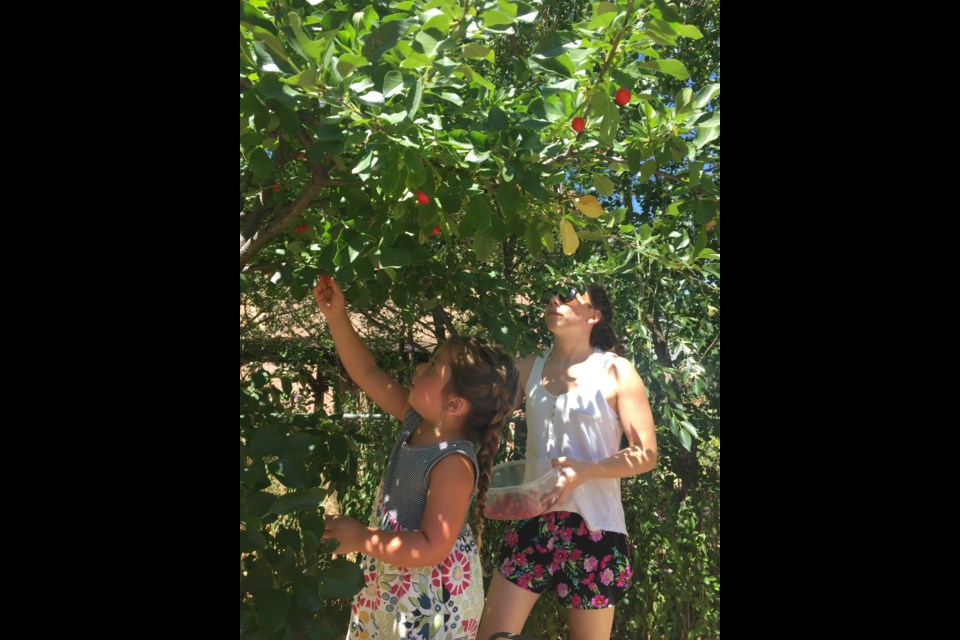This content was originally published by the Longmont Observer and is licensed under a Creative Commons license.
Written by Anne Quinn Corr
Cherries, summer’s ephemeral emblem, are patriotically making an appearance just in time for the 4th of July. The Longmont Farmers Market will have some for the next few weeks, but they will be in high demand. They are scarce—which makes the few that come our way even more precious.
Before we moved to Longmont, we went up to Jamestown two years ago for the 4th celebration and to enter the pie contest there. I was determined to find sour cherries and make a pie but had no luck at any of the farms or supermarkets. We ended up making a blueberry pie and a peach and raspberry pie and took second and third in the contest—but I know we would have nailed it had I been able to find those cherries. The next day we moved in to our Air BnB in Lyons and right in the back yard, in full fruit, was a sour cherry tree. More pie!
The first of the stone fruits to ripen, cherries emanate from a single genus, Prunus, in the rose family. Prunus avium, the sweet cherry species, is also known as “bird’s cherry” and that is what you have to beat to the trees this time of year. Some of the popular varieties of sweet cherries include Bings, Lamberts, Golds, and Royal Annes.
Prunus cerasus is the sour cherry or “pie cherry” which is acidic and requires sugar to be palatable to most tastes. Two distinct strains of sour cherries have developed, amarelles, with pale red fruit and colorless juice, and morellos, which are dark red with red juice. Montmorency is a common sour cherry variety. A hybrid has resulted from a cross between the two species, the Duke, which derives from the given French name Medoc, later corrupted by the British to May Duke.
Sweet, sour and hybrid varieties are all nutritionally potent, a good source of potassium and vitamin A. Additionally, they contain compounds that seem to have antioxidant and anti-inflammatory properties. Back in the 1950’s Dr. Ludwig Blau, a Texan, was so crippled by gouty arthritis that he was confined to a wheelchair. His report in a Texas medical journal, at the time, claimed that including six cherries a day in his diet soon had him walking on his own. Subsequent trials reported equally beneficial results, though less so with rheumatic arthritis, and research today is still examining the effect.
The native habitat of cherry trees seems to have been western Asia and eastern Europe, though the unintentional distribution by birds makes an exact spot difficult to determine. The United States, with Michigan leading, is the largest producer of cherries; in 1997, 440 remillion pounds of sweet cherries and 279 million pounds of tart cherries.
In Japan, tree varieties are selected for the beauty of their flowers and most of these do not make cherries. In 1912 the mayor of Tokyo presented Washington DC with the thousands of seedlings that were planted around the Tidal Basin, an everlasting visual treat in early spring that, no doubt, the city workers are quite glad don’t drop fruit.
Celebrate cherry season with big bowls of fresh cherries or stroll on over to the West Side Tavern and try the Bada Bing cherries they use in some of their craft cocktails. Sweet.
Sour Cherry Pie
- Makes one pie
4 cups sour cherries, pitted and drained
- 1 and one third cup sugar
- 1 tablespoon cornstarch
- one eighth teaspoon salt
- 2 tablespoons butter Pastry for a 2 crust pie
Preheat oven to 350° F. After pitting the cherries, combine the sugar, cornstarch, and salt and toss to coat the fruit. Scoop into a pie pan lined with pastry. Dot with the butter and top with strips of pastry to make a lattice top. Crimp the edge. Bake at 350° F for about 45 minutes.
Anne Quinn Corr is a volunteer contributor to the Longmont Observer. Portions of this article previously appeared in the Centre Daily Times, a newspaper in State College, PA, and appear with the publisher’s permission.



